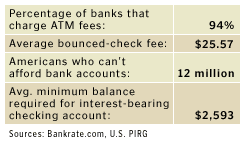
New York (CNN/Money) - Think twice before using any old ATM machine or letting your account balance dwindle. It could cost you a small fortune.
That's the conclusion of the most recent checking account survey from Bankrate.com, which estimates that American consumers will pay $2.27 billion this year just to use their ATM cards.
"It used to be that banks held our money, we'd get it when we wanted and they made more interest [on consumers' deposits] than what they paid out. They made a little money on the spread. But those days are gone," said Bankrate Editor Daniel Ray.

According to the study, a typical consumer pays roughly 15 percent - or $2.99 - in fees when they withdraw $20 from an ATM machine not owned by their bank. Half of that charge is an "off use" fee that 88 percent of banks charge their own customers for using a competitor's ATM. Of course, fees may even be higher. Thirteen percent of banks, for example, charged non-customers $2 for the privilege of using their money machines.
It's all but impossible not to pay to use an ATM that doesn't belong to your bank. In its most recent banking survey, U.S. Public Interest Group found that 94 percent of all banks charge ATM fees.
Still there are ways to minimize costs by shopping around for banks that charge reduced fees or waive them if you have a certain balances. You can compare fees by logging onto our online search tool or through Bankrate. You may find that it's cheapest to move to an online bank.
If you do need last-minute cash and your bank's ATM machine isn't close by, you may be able to skirt surcharges by requesting cash back when you go shopping. Eighty-three percent of banks don't charge fees for, say, getting $20 back when you use your bank card to pay for purchases at vendors such as grocery stores and pharmacies, according to Bankrate.com.
| Related banking tools and articles
|

|
|
| • |
Checking account rate search
|
|
|
|
|
Meanwhile, keep an eye on your balance � especially if you've got an interest-bearing checking account. That's because you must maintain a minimum balance of $2,593 at an average interest-paying bank to avoid fees. (That's nearly twice as much as the $1,308 balance required at online banks.) Non-interest checking accounts have far lower minimum balance requirements - $357 on average.
High balance requirements aren't the only reason to avoid interest-paying checking accounts. These days low yields have made them potentially costly, too. In fact, more than eight out of 10 banks pay less than 1 percent in interest. At those rates, a typical consumer is probably paying more in fees than they can make in interest, said Ray.

|

